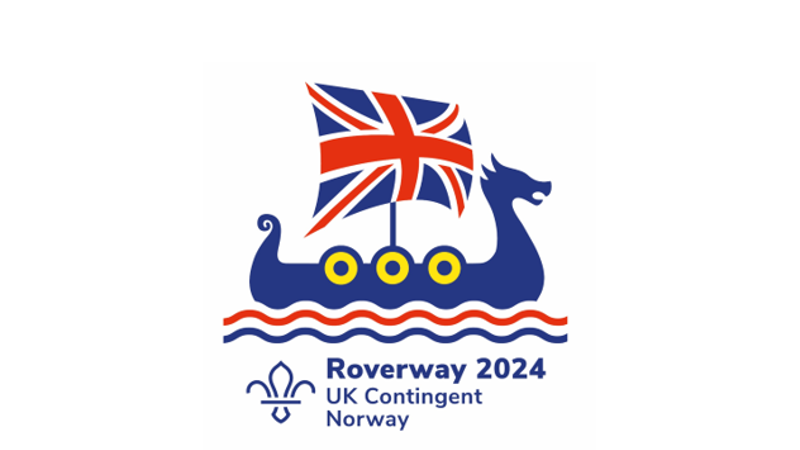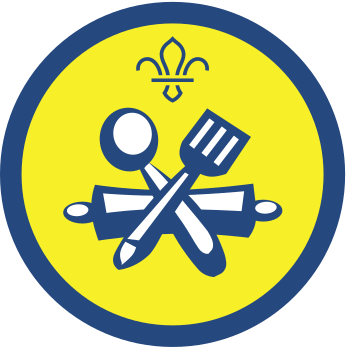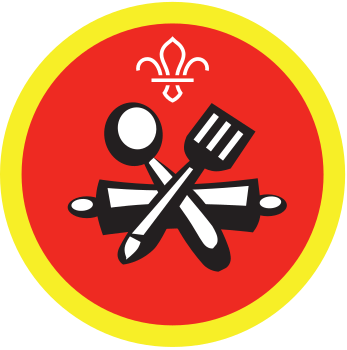
Make Norwegian Waffles
You’ll need
- Mixing bowls
- Wooden spoons
- Tape measure
- Kitchen scales
- Cooking utensils
- Access to water
- Access to a sink
- Waffle pan (or waffle maker or griddle pan)
- Whisk
- Measuring jug
- Cooling rack
- Timer (optional)
- Heatproof bowl/jug (optional)
- Sauce pan (optional)
- Microwave (optional)
Før du begynner (Before you begin)
- Use the safety checklist to help you plan and risk assess your activity. Additional help to carry out your risk assessment, including examples can be found here. Don’t forget to make sure all young people and adults involved in the activity know how to take part safely.
- Make sure you’ll have enough adult helpers. You may need some parents and carers to help if you’re short on helpers.
Roverway is a European event for Scouts and Guides aged 16 to 22, which takes place every three to six years. It is a unique event due to its age range and emphasis on youth-led adventure.
The next Roverway will take place in Norway in summer 2024. The event is divided into three parts: a semi-independent expedition, a jamboree-style camp and a post-event experience. Find out more on our Roverway 2024 page.
Norway is a Scandinavian country in Northern Europe that has mountains, glaciers and big bodies of water, which are called fjords. Many Norwegians embrace the nature through outdoor activities such as kayaking, hiking and skiing. Oslo is the capital of Norway.
Waffles are eaten in all of the Scandinavian countries, but they have a special place in Norway. Waffles are just as important to Norwegians as the croissant is to the French. Waffles are ever-present in Norway, they are sold at cafés and made at home. Like another iconic Nordic dish, meatballs, they represent a sense of belonging. The taste of home.
Unlike American or Belgian waffles, the Scandinavian waffles are thinner and heart-shaped.
In most parts of Norway the forest starts where your garden ends. Dotted all over the Oslo Forest, like lighthouses, are wooden cafés. They pride themselves on whipping up the best waffles you can get in the forest, cooking them fresh over open fires.
- Check for allergies, eating problems or dietary requirements and adjust the recipe as needed. Make sure you've checked everyone's dietary requirements and allergies then adapted the recipe as appropriate. This may include making sure there’s no cross-contamination during the storage, preparation, cooking and serving of the food.
- Use separate cooking equipment or utensils, such as tongs, for different dietary requirements, allergies and foods.
- Check if there are any items of food (or packaging) that people can’t touch or be near to, or if there are items that people might not be comfortable using in the activity.
- Some people may not like certain food textures or tastes and that’s OK. Try to find an alternative for them. No-one has to use all the ingredients or be made to try foods if they’re not happy, comfortable or don’t want to.
- Be conscious about who may be fasting when running a food-related activity – you may want to plan it for when everyone can get involved.
- You could run our kitchen safety and hygiene activities, Kitchen risk bingo and Home kitchen hygiene prior to running this session.
- Remember to have a hand washing station and take extra hygiene precautions when handling food. Take a look at our guidance on food preparation.
- Make sure you have all the ingredients ready.
- You may want to run a kitchen safety talk and show people how to use the equipment safely, such as for cooking or chopping ingredients.
- If using a gas stove, make sure it’s on a stable heatproof surface and in a clear and open area, with plenty of ventilation. Gas can increase risk of carbon monoxide exposure. We have more guidance on different cooking methods.
- Depending on your meeting place, you may wish for groups to prepare the ingredients in a wider, more spacious area, then invite each group into the kitchen to cook one at a time. Remember the groups not using the kitchen or cooking will still need to be supervised, always following the Yellow Card.
Gjør klar denne aktiviteten (Setting up the activity)
-
Remember to give a safety briefing for the cooking equipment and methods you’re using. You may wish to demonstrate the methods or activity before you all start cooking.
Ingredients
- 6 eggs
- 275g sugar
- 750g white flour
- 2 tablespoons baking powder
- 1 tablespoon vanilla extract
- 1 litre of milk
- 190g melted butter
- 300g soured cream
Prep time: 5 minutes
Cook time: 3-5 minutes per waffle
Makes: 12-16 waffles
Gjør klar ingrediensene (Prepare the Ingredients)
- Gather everyone together in a circle. Explain that you’re going to make Norwegian waffles. Norwegian waffles are thin and shaped like a heart. They can be made for special occasions, but they may also be a daily treat. They are thinner than Belgian or American waffles, with a lighter texture.
- Everyone should wash their hands, then ask everyone to get into groups. They should gather the equipment and ingredients they need. An adult should always be assigned to and supervising each group during this activity.
- In one bowl, beat the eggs together with a whisk, while someone else gradually adds the sugar in.
- In another bowl, mix the flour and baking powder together.
- When ready, add 1/3 of the flour mixture into the egg mixture and mix together. Then add a third of the milk. You should then keep repeating this until all the flour mixture and milk is combined in the bowl with the egg mixture.
- Add the butter to a heatproof bowl or jug and gently melt either in a pan or a microwave. It should take about 30 to 45 seconds, in the microwave depending on the amount of butter. Once it’s ready, an adult should use heatproof gloves to set the bow/pan to one side on a heatproof mat, in a safe place to let the butter cool slightly.
- When it’s cooled, an adult should add the melted butter to the mixture. Mix the butter into the ingredients well.
- Next add in the soured cream and vanilla extract to the mixture and stir well, then let the batter rest for a few minutes.
Lag maten! (Make the food!)
- When you’re ready to cook, make sure that whichever you are using; a waffle pan, waffle maker or griddle pan is hot and ready.
- You may need to put cooking spray, butter, or oil on it if it's not non-stick. Once your pan or maker is hot, an adult should carefully pour on the batter. If it leaks out, you may have added too much.
- Remember, if people need to use different batters for dietary requirements, they may need to use separate waffle makers or pans.
- Cook the batter for 3-5 minutes each, adjusting to your liking. As your waffle cooks, it'll probably release steam. Wait until the steam stops coming out before checking on the waffle to see if it’s cooked.
- When it’s ready, an adult should remove the waffles using a plastic, rubber, or silicone utensil and carefully place them on a plate to cool. They should be left to one side, on a heatproof surface and in a safe space.
- When the waffles have cooled, you can serve with your toppings of choice.
- When finished, unplug or take your tools off the heat and place them to one side to cool down, making sure they're on heatproof surface and out of reach of young people. Remember to follow the manufacturer’s cleaning instructions.
Reflection
This activity gave everyone the opportunity to try something new and work as a team to cook some waffles. Have you made anything similar before? How easy was it to make the waffles? What did they taste like? What toppings did you add?
You had to work as a team to make the waffles. How did you make sure everyone could be involved? How did you make sure everyone could share and use their skills? Did everyone get to have a turn mixing the ingredients or making the waffles? Did you have any problems? How did you solve them?
Safety
All activities must be safely managed. You must complete a thorough risk assessment and take appropriate steps to reduce risk. Use the safety checklist to help you plan and risk assess your activity. Always get approval for the activity, and have suitable supervision and an InTouch process.
- Hot items and hot water
Kettles, cookers and microwave ovens produce a lot of heat by the very nature of them. Caution is needed when in contact with items that have been heated and young people should use them under adult supervision. Use on a suitable surface, protecting it if necessary. Never leave hot items unattended and make sure there’s a nearby first aid kit, with items to treat burns/scalds.
- Food
Remember to check for allergies, eating problems, fasting or dietary requirements and adjust the recipe as needed. Make sure you’ve suitable areas for storing and preparing food and avoid cross contamination of different foods. Take a look at our guidance on food safety and hygiene.
- Cooking
Teach young people how to use cooking equipment safely. Supervise them appropriately throughout. Make sure it’s safe to use and follow manufacturers’ guidelines for use.
- Fires and stoves
Make sure anyone using fires and stoves is doing so safely. Check that the equipment and area are suitable and have plenty of ventilation. Follow the gas safety guidance. Have a safe way to extinguish the fire in an emergency.
- Sharp objects
Teach young people how to use sharp objects safely. Supervise them appropriately throughout. Store all sharp objects securely, out of the reach of young people.
- To make this activity easier, an adult could pre-make the batter, pre-make the waffles, or pre-buy the waffles so that young people just need to add toppings. This can still be a great way to begin a conversation about international cultures.
- To make this exercise harder, try cooking them outside on open fires. Ensure you make sure anyone using fires and stoves is doing so safely. Check that the equipment and area are suitable and have plenty of ventilation. Follow the gas safety guidance. Have a safe way to extinguish the fire in an emergency.
- If anyone needs help or struggles with fine motor skills, give them the opportunity to work in pairs or small groups. They could also work with a young leader or an adult volunteer. The person they’re working with can help with the parts they find fiddly to do or tricky. A funnel could be used to help them pour the ingredients into a bowl or jug.
- If you’re measuring out ingredients, anyone who struggles with measuring can partner up with or join a group with someone who’s more confident at this part of this activity. Alternatively, a young leader or adult could support them.
- Remember, some baking and cooking activities can be done either sitting or standing – people can choose whichever way is best for them. People could work with a partner, with one taking on any standing tasks and the other doing tasks seated.
- There are lots of loud noises and different smells in a kitchen or while cooking, which may overwhelm some people. People may choose to wear ear defenders while in the kitchen, take a break from the activity or prefer to stay a distance away from the activity and that’s OK. You could use fragrance free soap or washing up liquid or have items pre-chopped to reduce noise. You might also want to keep any blending, electric whisks or noisier equipment to being used in one room and shut the door, so people have an option to step out if it’s too loud. Check before and during the activity that everyone is comfortable, and make sure everyone knows that they can leave the activity at any point. It might be useful to agree a signal people can use, such as raising their hand, to stop take a break for the activity or if they need to speak to an adult.
All Scout activities should be inclusive and accessible.
If you enjoyed this activity, you could try making the national dish of Norway (Fårikål).


